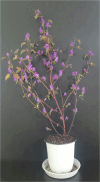Haplotype-resolved chromosome-level genome sequence of Elsholtzia splendens (Nakai ex F.Maek.)
- PMID: 40394069
- PMCID: PMC12092835
- DOI: 10.1038/s41597-025-05214-2
Haplotype-resolved chromosome-level genome sequence of Elsholtzia splendens (Nakai ex F.Maek.)
Abstract
Elsholtzia splendens, a perennial herb native to East Asia, is valued for its ornamental and medicinal uses, particularly in treating inflammatory and febrile conditions. Recent studies have highlighted its antibacterial, anti-inflammatory, antidepressant, antithrombotic, and lipid-lowering properties of its compounds. Additionally, E. splendens shows potential for phytoremediation owing to its ability to hyperaccumulate copper (Cu), lead (Pb), zinc (Zn), and cadmium (Cd). However, its role in remediation conflicts with its medicinal use because of the risk of heavy metal accumulation. Genome sequencing will be key to boosting beneficial compound production and reducing heavy metal risks. In this study, we generated a high-resolution, haplotype-resolved, chromosome-scale genome sequence of E. splendens using PacBio Revio long-read, Illumina short-read, and Hi-C sequencing technologies. The haplotype genome assemblies, spanned 275.4 and 265.0 Mbp with a scaffold N50 of 33.9 and 33.8 Mbp for haplotype 1 and 2, respectively. This assembly provides valuable insights into medicinal compound biosynthesis and supports genetic conservation efforts, facilitating future genetic and biotechnological applications of E. splendens for medicinal and ecological uses.
© 2025. The Author(s).
Conflict of interest statement
Competing interests: The authors declare no competing interests.
Figures





Similar articles
-
Chromosome-level and haplotype-resolved genome assembly of Bougainvillea glabra.Sci Data. 2025 Jan 18;12(1):107. doi: 10.1038/s41597-024-04333-6. Sci Data. 2025. PMID: 39827170 Free PMC article.
-
Chromosome-level genome and annotation of the tetraploid Rhodiola kirilowii.Sci Data. 2025 Apr 14;12(1):620. doi: 10.1038/s41597-025-04962-5. Sci Data. 2025. PMID: 40229289 Free PMC article.
-
Haplotype-resolved chromosomal-level assembly of wasabi (Eutrema japonicum) genome.Sci Data. 2023 Jul 11;10(1):441. doi: 10.1038/s41597-023-02356-z. Sci Data. 2023. PMID: 37433828 Free PMC article.
-
Haplotype-resolved chromosome-level genome assembly of Huyou (Citrus changshanensis).Sci Data. 2024 Jun 7;11(1):605. doi: 10.1038/s41597-024-03437-3. Sci Data. 2024. PMID: 38849389 Free PMC article.
-
Unlocking plant genetics with telomere-to-telomere genome assemblies.Nat Genet. 2024 Sep;56(9):1788-1799. doi: 10.1038/s41588-024-01830-7. Epub 2024 Jul 24. Nat Genet. 2024. PMID: 39048791 Review.
References
-
- Plants of the World Online. Facilitated by the Royal Botanic Gardens, Kew. Published on the Internet edn (2024).
-
- Kim, W. S. & Lim, Y. Antithrombotic Activity of Extracts from the Aromatic Herb Elsholtzia splendens. Biomedical Science Letters23, 277–280 (2017).
-
- Kim, D. W. et al. Anti-inflammatory activity of Elsholtzia splendens. Archives of Pharmacal Research26, 232–236 (2003). - PubMed
-
- World Health Organization. Regional Office for the Western Pacific. Medicinal plants in the Republic of Korea: information on 150 commonly used medicinal plants, (WHO Regional Office for the Western Pacific, Manila, 1998).
MeSH terms
Grants and funding
LinkOut - more resources
Full Text Sources
Miscellaneous

